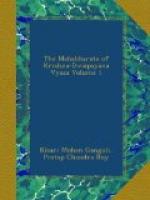91. Abode of Varuna in the original.
92. Garuda.
93. Pavana, the God of the wind.
94. There is a difference of reading here. Some texts read fifty seven,
95. A difference of reading is observable here.
96. As a purificatory ceremony, called the Achamana. To this day, no Hindu can perform any ceremony without going through the Achamana in the first instance.
97. Traditions represents the sons of king Sagara of the Ikshwaku race as the excavator of the ocean. Hence the ocean is called Sagara.
98. Lit. an engine killing a hundred. Perhaps, some kind of rude cannon.
99. Perhaps, brands or torches steeped in wax, intended to be thrown in a burning state, amongst the foe. Readers of Indian history know how Lord Lake was repulsed from Bharatpore by means of huge bales of cotton, steeped in oil, rolled from the ramparts of that town, in a burning state, towards the advancing English.
100. Lit. be a Purusha (male)! Manhood would not be appropriate in connection with a Rakshasa.
101. This weapon could restore an insensible warrior to consciousness, as the Sam-mohana weapon could deprive one of consciousness.
102. Visalya a medicinal plant of great efficacy in healing cuts and wounds. It is still cultivated in several parts of Bengal. A medical friend of the writer tested the efficacy of the plant known by that name and found it to be much superior to either gallic acid or tannic acid in stopping blood.
103. The Guhyakas occupy, in Hindu mythology, a position next only to that of the gods, and superior to that of the Gandharvas who are the celestial choristers. The White mountain is another name of Kailasa, the peak where Siva hath his abode.
104. According to both Vyasa and Valmiki, there is nothing so fierce as a Brahmana’s curse. The very thunderbolt of Indra is weak compared to a Brahmana’s curse. The reason is obvious. The thunder smites the individual at whom it may be aimed. The curse of Brahmana smites the whole race, whole generation, whole country.
105. Abhijit is lit, the eighth muhurta of the day, a muhurta being equal to an hour of 48 minutes, i.e. the thirtieth part of a whole day and night. The Vaishnava asterism is as explained by Nilakantha, the Sravava.
106. Also called Gayatri, the wife of Brahma.
107. In the original., Vimanam, i. e., a car.
108. Samhritya—killing.
109. Lit. Letters.
110. Behind the plain and obvious meanings of the words employed both in the question and the answer, there is a deeper signification of a spiritual kind. I think Nilakantha has rightly understood the passage. By Aditya, which of course commonly means the Sun, is indicated the unpurified soul (from adatte sabdadin indriadivis &c.). The first question then, becomes, ‘Who is it that exalteth the unpurified soul?’




